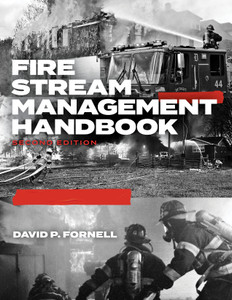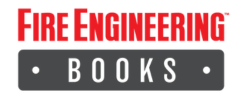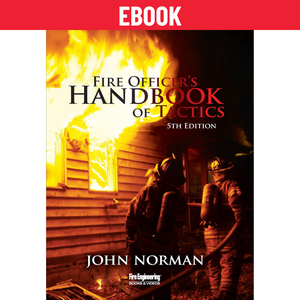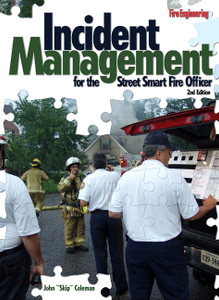
Fire Stream Management Handbook, 2nd edition - eBook
David P. Fornell
$52.00
Fire Stream Management Handbook, 2nd edition
By: David P. Fornell
For over 60 years, David P. Fornell has studied and refined the science of fire stream management, ensuring water is applied effectively and safely in structural firefighting. This 2nd ed. guide covers water movement, flow rates, penetration, and stream selection, helping firefighters maximize suppression efficiency while minimizing risks to personnel and property.
Firefighting tactics evolve, but one constant remains: water is our most powerful tool. Despite advancements in aggressive attack strategies, firefighters and buildings continue to suffer preventable fire-related damage and injuries. This book returns to the basics—mastering fire stream application to improve fireground safety, efficiency, and success.
Key Topics Covered in this edition
-
Fire Stream Basics – Understanding flow rate, reach, and penetration for optimal suppression.
-
Tactical Fire Attack – Applying water effectively while coordinating with ventilation and overhaul.
-
Nozzle Selection & Operation – Smoothbore vs. combination nozzles, automatic nozzles, and more.
-
Fireground Hydraulics – Managing water supply, pressure, and friction loss for maximum efficiency.
-
Strategic Considerations – Evaluating hose size, stream application, and fire behavior in various structures.
Built on decades of real-world experience, Fire Stream Management Handbook, 2nd Ed. is a must-read for firefighters, company officers, and training instructors who want to enhance fireground effectiveness and firefighter safety.
*****
Table of Contents
Foreword by Andrew O’Donnell
Acknowledgments
Introduction
1. Fire Stream Basics
- Basic Hydraulics
- Introduction To Water Movement
- Factors Affecting Friction Loss
- Water Movement Terms
- Fire Pump Operations
- Onboard Water Tank Operations
- Drafting
- Supply Line Hydraulics
- Forward Lay Supply Operations
- Determining Supply Line Hose Sizes
- Ways of Increasing Supply Line Flows
- Laying Additional Lines
- Increasing Hoseline Diameter
- Increasing Pressure to Increase Flow
- Combining Procedures
- Managing Water Supplies
- Get Water Out of the Pump
- Factors Affecting Water Movement
- Simplifying Water Delivery Calculations
- A Brief Review
- Chapter 1 Review Questions
2. Strategic Considerations
- Setting Goals
- Legal Challenges
- Extinguishing More Fire with Fewer Personnel
- Response District Evaluation
- How Much Flow Do You Apply?
- Personnel Requirements
- Establishing Flow Rates
- Fire Flow Formulas
- Individual Line Flows
- Unwritten Planning
- Evaluating Rates of Flow and Areas of Application
- Evaluation of Line Sizes
- Reaching the Fire
- High-Volume Handlines
- High-Rise Buildings
- Review
- Chapter 2 Review Questions
3. Nozzle Theory
- Basic Methods
- Direct Attack Method
- Indirect Attack Method
- Indirect Attack Theory
- Iowa Research
- Evaluating Indirect Attack Tactics
- Underwriters Laboratories Fire Safety Research Institute Research
- Stream Selection for Penetration
- Life Safety During Firefighting Operations
- Other Testing
- Indirect Approach Applications
- Development Of Sensible Tactics
- Preventing and Mitigating the Effects of Flashover
- Chapter 3 Review Questions
4. Nozzle Basics
- Basic Nozzle Design
- Nozzle Components
- Nozzle Types
- Nozzle Basics
- World War II
- The Early Days of Fog for Structural Use
- Stream Pattern Control
- Controlling Gallonage
- Shutoff Devices
- Flush Features
- Teeth
- Protection Myth
- Combination Nozzle Types
- Using the Adjustable Gallonage Nozzle in Place of the Automatic Nozzle
- Distributor and Piercing Nozzles
- Opposed Discharge Nozzle
- Bent Discharge Nozzle
- High-Pressure Delivery
- Conserving Water versus Extinguishing the Fire
- Fog Pressure Apparatus in Chicago
- Modern Experience with High-Pressure Delivery
- U.S. Air Force High-Pressure Operation
- Chapter 4 Review Questions
5. Automatic Nozzles
- Automatic Nozzle Design
- High-End Performance
- The Automatic Nozzle’s Ability to Increase Flow
- Automatic Nozzle Operation at Lower Flows
- Utilizing Automatics
- Automatic Nozzle Master Stream Operation
- Handline Operation Using Automatic Nozzles
- High-Pressure/Maximum Volume Method of Operation
- Fixed-Gallonage Method of Operation
- Predetermined Pressure Method of Operation
- Nozzle Evaluation
- Handline Nozzle Reaction
- Automatic Nozzle Flow Ranges
- Pump Operation for Automatic Nozzles
- Operational Hints
- Attempting To Evaluate Amount of Flow
- Chapter 5 Review Questions
6. Smoothbore Nozzles
- Nozzle Comparison
- Smoothbore Nozzle Tips
- Effect of Tip Size Selection
- Smoothbore Firefighting Tactics
- The Smoothbore Nozzle’s Operational Advantages
- Penetration
- Managing Unwanted Steam
- Smoothbore Nozzle Use with Standpipes
- Reducing Stress
- Training
- Combination Stream Attack
- Twin Tips
- Threaded Tip Styles
- Variations on Common Smoothbore Nozzles
- Conclusion
- Chapter 6 Review Questions
7. Low-Pressure Nozzles
- High-Flow Handlines
- The History of Low-Pressure Combination Nozzles
- The Low-Pressure Age Begins
- Safety In Handling
- Low-Pressure Nozzle Evaluations
- Converting Present Nozzles
- Explanation of Nozzle Reaction Forces
- Review
- Chapter 7 Review Questions
8. Heavy Streams
- Heavy Stream Equipment
- Combination Aerial and Pumper Apparatus
- Heavy Stream Nozzles
- Using Heavy Streams Effectively
- Blitz Attack Tactics
- Mounting
- Large Fire Combat Tactics
- Staging Area
- Considering the Effectiveness of Smoothbore Streams
- Ground-Attack Monitors
- Fighting a Losing Battle
- Protecting Exposures
- Directing Heavy Streams
- Heavy Stream Safety
- Chapter 8 Review Questions
9. Fire Hose Basics
- Hose Construction
- Fire Hose Yarns
- Fire Hose Sizes
- Fire Hose Pressure Ratings
- Countering the Effects of Heat and Wear
- Rubber-Covered Hose
- Other Methods of Protecting Hose
- Forestry Hose
- A Discussion About Lightweight Lined Hose
- Hose for High-Rise Use
- Large-Diameter Hose
- Large-Diameter Flow Systems
- Inspection and Maintenance
- Chapter 9 Review Questions
10. Class A Foam
- History
- Development of a Suitable Agent
- What Are Class A Agents?
- Putting Class A Agents to Work
- Premix or Batch Mixing
- Discharge-Side Eductors and Proportioners
- Balanced- and Positive-Pressure Injection Metering Systems
- Compressed Air Injection
- Using Class A Extinguishing Agents for Structural Firefighting
- Increasing Firefighter Safety by Using Class A Agents
- Class A Agents on Class B Fires
- The Future of Class A Agents
- Chapter 10 Review Questions
11. Tactical Fire Attack
- Engine Company Size-Up
- The Art of Applying the Water
- Ventilation
- Overhaul
- Water Damage
- What Happens When Unwanted Steam Is Generated?
- Preventing Fire Spread by Stream Placement
- Ventilation in Conjunction with Engine Work
- Consider Water Supply
- Summary
- Chapter 11 Review Questions
12. Managing Hose
- Attack Line Hose Loads
- Preconnected Beds
- Bulk Hosebeds
- Reverse Lays
- Forward Lays
- Flying Lay
- Handling the Line
- Summary
- Chapter 12 Review Questions
13. Evaluation and Maintenance
- Nozzle Operation Review
- Performing Evaluations
- Equipment For Evaluation
- Purchasing Equipment
- Pricing Factors
- Nozzle Maintenance
- Maintenance Procedures
- Repair Parts
Chapter 13 Review Questions
Answers for Chapter Review Questions
Index
About the Author
- Format:
- eBook
- Number of Pages:
- 376
- Published Date:
- February 2025
- ISBN:
- E9781593706098
Reviews
-
Fire Streams
This. Edition like the first edition continues to educate the firefighter and Fire Officer on nozzles and the importance of fire flow.






